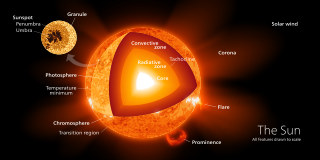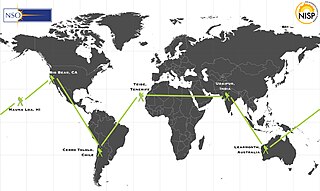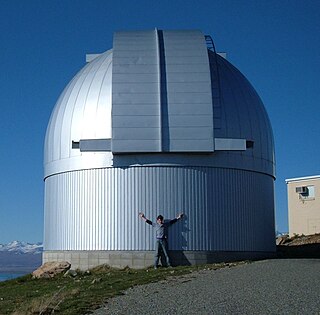Related Research Articles

CoRoT was a space telescope mission which operated from 2006 to 2013. The mission's two objectives were to search for extrasolar planets with short orbital periods, particularly those of large terrestrial size, and to perform asteroseismology by measuring solar-like oscillations in stars. The mission was led by the French Space Agency (CNES) in conjunction with the European Space Agency (ESA) and other international partners.

Asteroseismology is the study of oscillations in stars. Stars have many resonant modes and frequencies, and the path of sound waves passing through a star depends on the speed of sound, which in turn depends on local temperature and chemical composition. Because the resulting oscillation modes are sensitive to different parts of the star, they inform astronomers about the internal structure of the star, which is otherwise not directly possible from overall properties like brightness and surface temperature.
Helioseismology, a term coined by Douglas Gough, is the study of the structure and dynamics of the Sun through its oscillations. These are principally caused by sound waves that are continuously driven and damped by convection near the Sun's surface. It is similar to geoseismology, or asteroseismology, which are respectively the studies of the Earth or stars through their oscillations. While the Sun's oscillations were first detected in the early 1960s, it was only in the mid-1970s that it was realized that the oscillations propagated throughout the Sun and could allow scientists to study the Sun's deep interior. The modern field is separated into global helioseismology, which studies the Sun's resonant modes directly, and local helioseismology, which studies the propagation of the component waves near the Sun's surface.
Solar radius is a unit of distance used to express the size of stars in astronomy relative to the Sun. The solar radius is usually defined as the radius to the layer in the Sun's photosphere where the optical depth equals 2/3:

A radiation zone, or radiative region is a layer of a star's interior where energy is primarily transported toward the exterior by means of radiative diffusion and thermal conduction, rather than by convection. Energy travels through the radiation zone in the form of electromagnetic radiation as photons.

The Global Oscillation Network Group (GONG) is a worldwide network of six identical telescopes, designed to have 24/7 observations of the Sun. The network serves multiple purposes, including the provision of operation data for use in space weather prediction, and the study of solar internal structure and dynamics using helioseismology.

Microlensing Observations in Astrophysics (MOA) is a collaborative project between researchers in New Zealand and Japan, led by Professor Yasushi Muraki of Nagoya University. They use microlensing to observe dark matter, extra-solar planets, and stellar atmospheres from the Southern Hemisphere. The group concentrates especially on the detection and observation of gravitational microlensing events of high magnification, of order 100 or more, as these provide the greatest sensitivity to extrasolar planets. They work with other groups in Australia, the United States and elsewhere. Observations are conducted at New Zealand's Mt. John University Observatory using a 1.8 m (70.9 in) reflector telescope built for the project.

The core of the Sun is considered to extend from the center to about 0.2 of solar radius. It is the hottest part of the Sun and of the Solar System. It has a density of 150,000 kg/m3 (150 g/cm3) at the center, and a temperature of 15 million kelvins.
Solar-like oscillations are oscillations in stars that are excited in the same way as those in the Sun, namely by turbulent convection in its outer layers. Stars that show solar-like oscillations are called solar-like oscillators. The oscillations are standing pressure and mixed pressure-gravity modes that are excited over a range in frequency, with the amplitudes roughly following a bell-shaped distribution. Unlike opacity-driven oscillators, all the modes in the frequency range are excited, making the oscillations relatively easy to identify. The surface convection also damps the modes, and each is well-approximated in frequency space by a Lorentzian curve, the width of which corresponds to the lifetime of the mode: the faster it decays, the broader is the Lorentzian. All stars with surface convection zones are expected to show solar-like oscillations, including cool main-sequence stars, subgiants and red giants. Because of the small amplitudes of the oscillations, their study has advanced tremendously thanks to space-based missions.

A B-type subdwarf (sdB) is a kind of subdwarf star with spectral type B. They differ from the typical subdwarf by being much hotter and brighter. They are situated at the "extreme horizontal branch" of the Hertzsprung–Russell diagram. Masses of these stars are around 0.5 solar masses, and they contain only about 1% hydrogen, with the rest being helium. Their radius is from 0.15 to 0.25 solar radii, and their surface temperature is from 20,000 to 40,000 K.

The cyano radical (or cyanido radical) is a radical with molecular formula CN, sometimes written •CN. The cyano radical was one of the first detected molecules in the interstellar medium, in 1938. Its detection and analysis was influential in astrochemistry. The discovery was confirmed with a coudé spectrograph, which was made famous and credible due to this detection. ·CN has been observed in both diffuse clouds and dense clouds. Usually, CN is detected in regions with hydrogen cyanide, hydrogen isocyanide, and HCNH+, since it is involved in the creation and destruction of these species (see also Cyanogen).
In solar physics and observation, an active region is a temporary feature in the Sun's atmosphere characterized by a strong and complex magnetic field. They are often associated with sunspots and are commonly the source of violent eruptions such as coronal mass ejections and solar flares. The number and location of active regions on the solar disk at any given time is dependent on the solar cycle.
WASP-33b is an extrasolar planet orbiting the star HD 15082. It was the first planet discovered to orbit a Delta Scuti variable star. With a semimajor axis of 0.026 AU and a mass likely greater than Jupiter's, it belongs to the hot Jupiter class of planets.

Philip R. Goode is an American theoretical physicist also working in observational astronomy and its instrumentation. He is a Distinguished Research Professor of Physics at New Jersey Institute of Technology (NJIT) with an H-index > 60. His career divides into five overlapping periods as follows:
Douglas Owen Gough FRS is a British astronomer, Professor Emeritus of Theoretical Astrophysics in the University of Cambridge, and Leverhulme Emeritus Fellow.
Timothy R. Bedding is an Australian astronomer known for his work on asteroseismology, the study of stellar oscillations. In particular, he contributed to the first detections of solar-like oscillations in stars such as eta Bootis, beta Hydri and alpha Centauri. He also led the discovery, using data from the Kepler space telescope, that red giants oscillate in mixed modes that are directly sensitive to the core properties of the star and can be used to distinguish red giants burning helium in their cores from those that are still only burning hydrogen in a shell.
Kepler-429 is a variable subdwarf B star in the constellation Lyra, about 5,900 light years away.
WASP-69, also named Wouri, is a K-type main-sequence star 164 light-years away. Its surface temperature is 4782±15 K. WASP-69 is slightly enriched in heavy elements compared to the Sun, with a metallicity Fe/H index of 0.10±0.01, and is much younger than the Sun at 2 billion years. The data regarding starspot activity of WASP-69 are inconclusive, but spot coverage of the photosphere may be very high.
KIC 11145123, is a white hued star located in the northern constellation Cygnus, the swan. It has an apparent magnitude of 13.12, making it readily visible in large telescopes, but not to the naked eye. The object is located relatively far at a distance of approximately 3,910 light years, but is rapidly approaching the Solar System with a radial velocity of −136 km/s.
References
- ↑ The quest for solar g modes, 2009, Astronomy and Astrophysics Review, available at http://adsabs.harvard.edu/abs/2010A%26ARv..18..197A